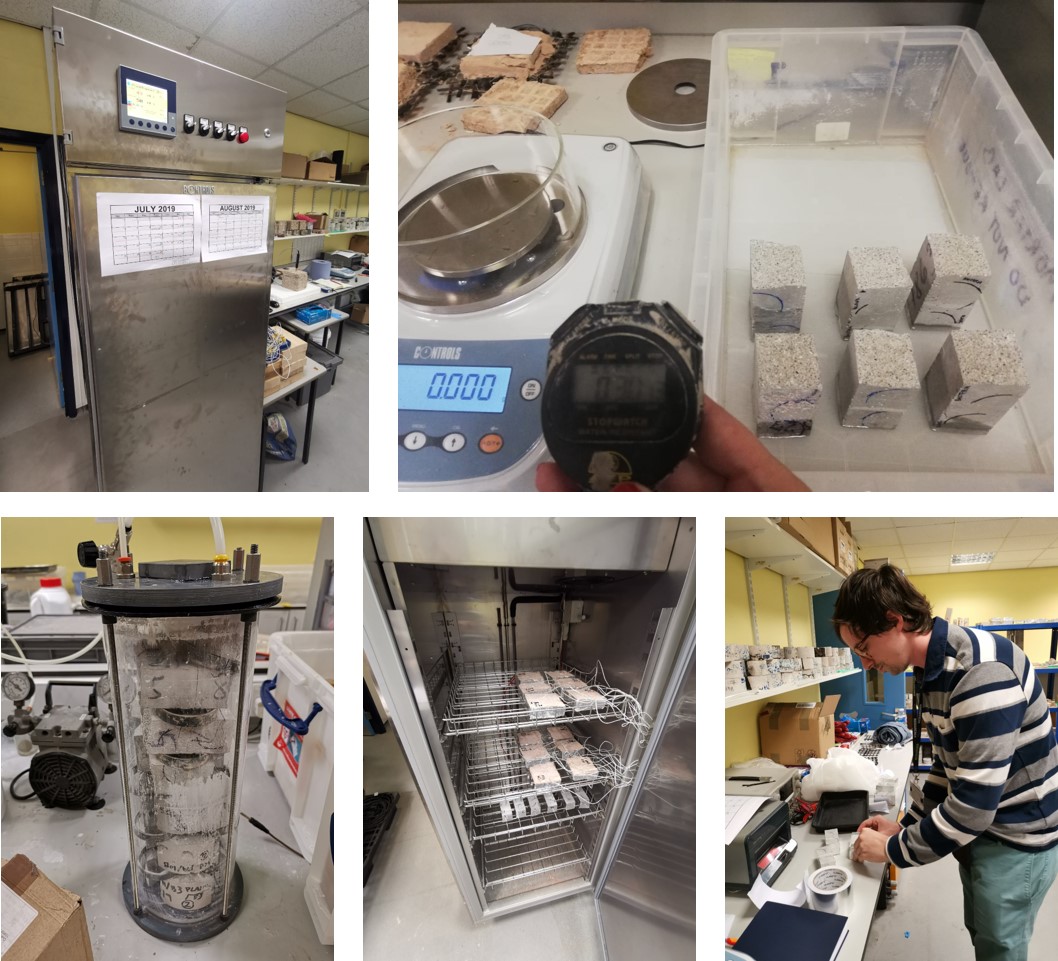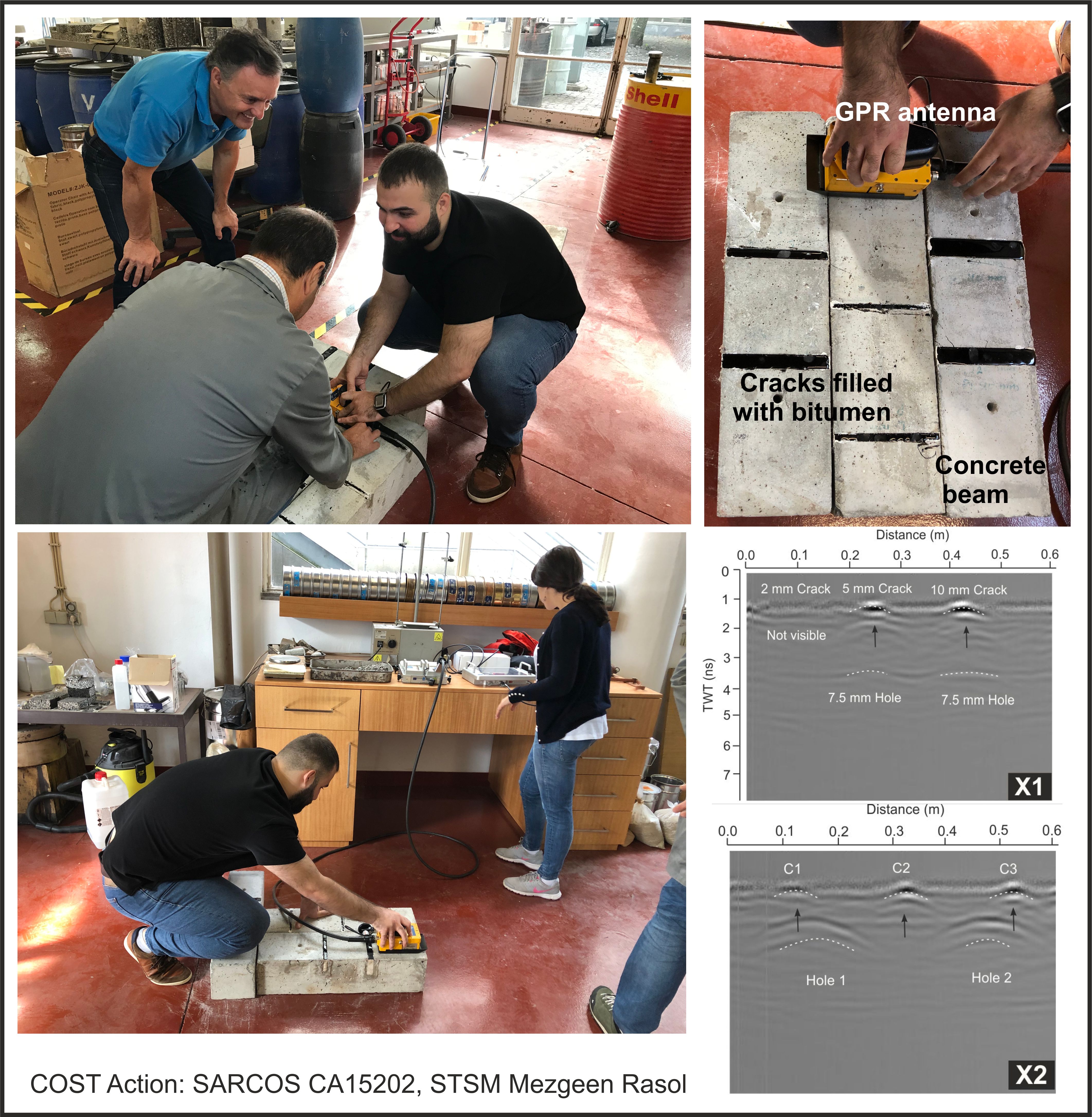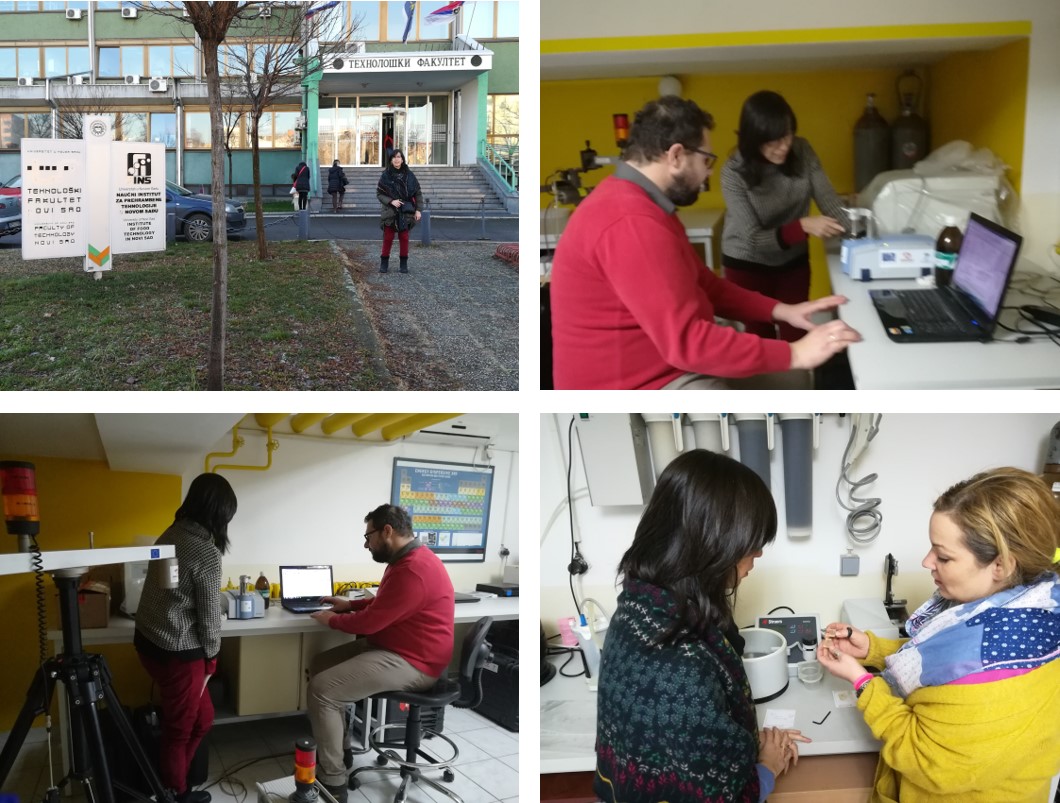Awarded STSMs
| CALL 8.0
Applicant: Liberato Ferrara, Politecnico di Milano, Milan (IT)
STSM Topic: Self-healing through bacterial deposition
Host: Jonjaua Ranogajec, University of Novi Sad, Novi Sad (RS)
Period: 07/05/2019 to 12/05/2019
Work Plan Summary:
The group of Prof. Ranogajec at University of Novi Sad is developing a new bacteria-based “healing promoter additive” technology for “self-healing” bio-concrete. A preliminary work on the development of bacteria healing agent encapsulated in the polymer hydrogel system has been already successfully done. The cells colony of the bacteria species of interest was monitored by measuring their lifetime in several types of polymer hydrogels and an optimization of the technological procedure was established. The efficacy of these systems have already preliminary assessed during the STSM of Dr. Bojan Milevic at Politecnico di Milano: specimens fabricated at University of Novi Sad were shipped to Milano and pre-cracked through a suitably controlled test methodology, cured and at regular intervals up to six months analysed with an optimal microscope for visual crack sealing and tested for water sorptivity changes. While the first results of the investigation were already summarized in a paper presented at the Synercrete’18 conference in Madeira, the applicant feel that an appropriate time to discuss the results together while working out at a journal paper is necessary to maximize the outcome of this synergy funded by the COST Action and this will be the main motivation of the STSM.
Applicant: Emilija Fidanchevski, Faculty of Technology and Metallurgy, Skopje (MK)
STSM Topic: The influence of SiO2 and Al2O3 on the properties and self-healing of cement base products
Host: Liberato Ferrara, Politecnico di Milano, Milan (IT)
Period: 28/06/2019 to 12/07/2019
Work Plan Summary:
The aim of the proposed short term scientific mission was to investigate the influence of silica and nano alumina in the cement based products. The content of silica and nano alumina used in the cement based products was investigated in therms to follow the mechanical properties and their effect on self-healing. Silica used in the investigation was obtained from rice husk and nano alumina was a commercial product. Cement employed in the investigation was commercial product from the cement plant Cementarnica USJE TITAN group. Also, the other purpose was to learn more in depth the techniques and methodology for selfhealing from the experienced group in this subject and to search the possibilities to up grade the actual conditions in home institution relating the self-healing.

Applicant: Claudio Larosa, University of Genoa, S' Martino (IT)
STSM Topic: Polycarbonate/graphene platelet composites applied to small cement crack repair
Host: Jonjaua Ranogajec, University of Novi Sad, Novi Sad (RS)
Period: 01/07/2019 to 14/07/2019
Work Plan Summary:
In order to seek for new solutions to repair small cracks, the research starts from commonly used routes including polymer fusions or single polymer press-molding or various polymer composites, and blending methods. The purpose of this STSM was to design polymer loaded graphene platelets (polycarbonategraphene platelet composites) and then use them to fill narrow cracks, delivering sustainable solutions. Graphene platelets as additives offer a higher resistance values to stretch and tensile forces, able to improve the optical protection of polycarbonate and stabilize the water exchange in composites. Therefore, because of native shape and a high surface area, graphene is proposed as an additive barrier against gas, liquids and microparticles in concretes. From the working plan and activities proposed, it was intended to collect data of concrete repair and PC stability showing a significant level of cement repair and stability for several years. The contribution to the scientific objectives of the Action was focused on the application of a sustainable solution to cement crack repair, in accordance with the COST action CA15202. Furthermore, this research on the self-healing approaches was considered to be in mutual interest for the host and the guest, promoting an interdisciplinary work in the field of external cement crack repair. The work addressed incorporation of additives as a load polymer matrix molded on the cracks. It also contributed to increase of available scientific knowledge in the field of composites characterisation and their application to small crack repairs by the interaction of graphene loaded polymer.
Applicant: John Milan van der Bergh, University of Novi Sad, Novi Sad (RS)
STSM Topic: Evaluation of self-healing capabilities in maritime conditions
Host: Ana Armada Brás, Liverpool John Moores University, Liverpool (UK)
Period: 06/07/2019 to 20/07/2019
Work Plan Summary:
The purpose of this STSM was to develop self-healing techniques for crack control of cement-based mortars in maritime environments. Within the scope of the WG1 of the “SARCOS” COST action, the research group of Prof. Ranogajec at the University of Novi Sad is aiming to further develop a new “healing promoter additive” technology for cement based mortars and concrete. This STSM comprised the first step in establishing collaboration between the Novi Sad research group mainly dealing with process technology and material composition characterisation, and Liverpool John Moores University research group of civil engineering experts led by Dr Ana Bras (Associate Professor), who focus on mechanical characteristics and durability of the produced material. The results of this STSM will serve as a basis for further investigations of the self-healing capabilities of cement-based mortars. Moreover, the results should support the future development of repair healing method by use of bacterial approach.

Applicant: Etelvina Javierre, Centro Universitario de la Defensa de Zaragoza, Zaragoza (ES)
STSM Topic: Modelling of autogenous self-healing reactions
Host: Anthony Jefferson, Cardiff University, Cardiff (UK)
Period: 28/07/2019 to 11/08/2019
Work Plan Summary:
The purpose of the STSM was to establish a strong and long lasting collaboration between the applicant and the host scientific team in the context of self-healing cementitious materials. The focus of this collaboration is set on the development of reactive flow models to simulate the chemical reactions that actively participate in the closure of cracks as well as on the development of appropriate schemes for their numerical solution. The participants in this STSM have previously used models based on transport phenomena in porous media to study different of autogeneous reactions in self-healing concrete. From this common ground, the work carried out during the STSM has been divided into the following steps: - a discussion of the modelling approaches and numerical schemes used by the participants, specifically focused on their complementary aspects; - a discussion of the experimental set ups that could be reproduced by the considered computational models in order to pursue the validation of the results in the future; - the design of a general purpose problem upon which build the complementary features that were identified in the first step; - the study of the research code Cardinal of the host team and the implementation of the general purpose problem in the Cardinal code. The designed general purpose problem consists of the coupled fluid flow and reactive transport model usually used in this context. Richards’ equation models the fluid flow through the porous concrete matrix, whereas a diffusion-reaction-convection equation appears for each dissolved chemical species under consideration. Given its direct effect on the reactive flow models, the numerical treatment of Richards’ equation was defined as the main target to be addressed during the STSM.

Applicant: Łukasz Sadowski, Wrocław University of Technology, Wrocław (PL)
STSM Topic: The micromechanical and self-healing properties of the epoxy resin coatings made with recycled fine aggregate for sustainable preventive repair of concrete substrates
Host: Sabine Weiß, Brandenburg Technical University, Cottbus (DE)
Period: 11/07/2019 to 13/10/2019
Work Plan Summary:
Epoxy resin coatings are popularly used in preventive repair of concrete substrates. The micromechanical and self-healing properties of the epoxy resin coatings significantly affect its final performance. Thus, they should be better recognized in order to identify the most important factors that influence its macroscopic behaviour. Therefore, the investigation of the micromechanical and self-healing properties of the epoxy resin coating in layered systems is not an easy task. Studying these properties is still a challenge for scientists and engineers. The manufacturers allowed to add a river aggregate (1-2 mm) as an extender of the epoxy resin coating to increase its volume. But the extraction of river aggregate is mostly located far away from places where it is used. The source of this material is not renewable and its high extraction around the globe has negative impact on environment. Summarizing above, the main aim of this STSM is to verify the impact of the partial river sand replacement with recycled fine aggregate on the properties of the epoxy resin coating. Special focus has been placed on the micromechanical and self-healing properties of the epoxy resin coatings made with recycled fine aggregate for sustainable preventive repair of concrete substrates.

Applicant: Fabiano Tavares Pinto, Universidad de Córdoba, Cordoba (ES)
STSM Topic: Remote-monitoring systems for non-destructive assessment of preventive repair solutions.
Host: Ana Margarida Armada Bras, Liverpool John Moores University, Liverpool (UK)
Period: 30/09/2019 to 22/10/2019
Work Plan Summary:
The main purpose of this STSM was to contribute both to WG1 and WG2 of SARCOS, as it deals with the development of advanced monitoring techniques for characterizing (WG2) the durability and performance of self-healing solutions (WG1). During my time in a short term mission (STSM) at Liverpool John Moores University, Liverpool, United Kingdom, we assessed the viability of integrating IoT systems for monitoring concrete durability through the study of different types of humidity and resistivity sensors as well as the associated technologies for data registration and transmission applied to bio-based concretes. First a wireless-monitoring system was applied on bio-based concretes. The idea is that these samples will be monitored for long term, changing the environmental conditions to promote the development of the selfhealing and to analyse if the sensing systems are able to detect the changes. This work was carried out in collaboration with Dr. Ana Armada Bras. Secondly the use of microwave sensors for quantification of moisture in concrete in real time was considered and training on this monitoring technique undertaken. Changes in the microwave part of the electromagnetic spectrum were used as an indicator of water quantity. The calibration of the he new monitoring sensors is being carried out by the durability tests that are being developing in SARCOS, within WG2, at the University of Córdoba, in collaboration with Dr. Badr Abdullah and Dr. Ana Armada Bras.

Applicant: Kamil Krzywiński
STSM Topic: Life Cycle Assessment of different repair and strengthening solutions for RC beams
Host: Carlos Chastre, Universidade NOVA de Lisboa, Lisbon (PT)
Period: 23/08/2019 to 13/09/2019
Work Plan Summary:
The purpose of this Short Term Scientific Mission was to perform the Life Cycle Assessment analysis for seven different strengthened Reinforced Concrete beams. They were used to analyse the replacement or the preventive repair process of the old RC beam in the structure due to additional planned loads which the old beam cannot resist. This topic was performed to compare traditional strengthening techniques (replacement of the beam by the new one or by adding new reinforcement) with new preventive repair solutions developed by Prof. Carlos Chastre’s work group. During the STSM the participant Kamil Krzywiński was able to increase his knowledge about RC beam preventive repair methods. He has learned and seen on-site processes needed to prepare the CREatE preventive repair method using CFRP reinforcement. Moreover, he has studied LCA based on the literature, in order to analyse all preventive repair methods for the RC beams studied.

Applicant: Mezgeen Rasol
STSM Topic: Exploration of Concrete Cracks filled with asphalt (Bitumen) in Concrete Pavements (Slab) by Using Non-destructive Method (GPR) and FDTD Simulation
Host: Laboratory of Civil Engineering, at University of Minho, Guimarães (PT)
Period: 09/09/2019 to 03/10/2019
Work Plan Summary:
This STSM contributed for Working Group 2, by analysing and evaluating different characterization techniques to quantify the cracking in cement concrete elements in term of depth and width, filled with bitumen material by using non-destructive screening and monitoring method (Ground Penetrating Radar). This configurations of the laboratory expriements representing the real conditions of the rigid pavements that can be repairaing cracks by filling with bitumen as a repair technique. Cracking in road pavements in both type of materials (asphalt or cement concrete) is one of the most frequent phenomena that occur due to deformation of the pavement or its deterioration caused by several factors, such as daily use of heavy load trucks, materials weathering and climacteric agents such as snow and rain.

Applicant: Gloria Pérez Álvarez-Quiñones
STSM Topic: Combined use of in situ characterization techniques for the analysis of multifuctional external repair coatings on mortar.
Host: Laboratory for Materials in Cultural Heritage, University of Novi Sad (RS)
Period: 26/01/2020 to 31/01/2020
Work Plan Summary:
The purpose of the STSM is for the applicant to receive raining from the host group (Laboratory for Materials in Cultural Heritage, University of Novi Sad) on the in situ analysis of multifunctional materials. The group from the home institution (IETcc-CSIC) is working on the introduction of nano-composite coatings to implement the self-repair ability on mortars combined with the addition of VO2 thermochromic nanoparticles to improve buildings energy efficiency. The proposal under development is to disperse selfhealing nanoparticles plus thermochromic nanoparticles and apply the dispersion as a multifunctional external repair coating onto mortar surfaces. These coatings are expected to be applied in real buildings,
so that their in situ characterization will be necessary. The host institution has wide experience in the application of nanoparticles dispersions on materials surfaces and possesses the necessary equipment for in situ chemical, structural and micro-structural analysis. The aim of the stay is to receive training from the host group on the necessary portable equipment for the in situ characterization of multifunctional coatings through XRF, FTIR, XRD, IR thermographic imaging
and optical microscopy and on the combined analysis of the results from these techniques to obtain a complete characterization of building materials properties

Applicant: Paloma Sirvent de Haz
STSM Topic: Dispersion of thermochromic VO2 nanoparticles into a multifunctional external repair coating for mortars
Host: Instituto de Ciencias de la Construcción Eduardo Torroja (IETcc), Consejo Superior de Investigaciones Científicas (CSIC), Madrid (ES)
Period: 26/01/2020 to 21/02/2020
Work Plan Summary:
The aim of the stay is to implement thermochromic functionalities to the self-healing treatments which are being investigated for concrete external healing repair. The introduction of self-healing properties are intended to increase mortars durability by self-repairing cracks generated due to mechanical loads. On the other hand, the addition of the thermochromic functionality is aimed here to improve buildings energy efficiency. Thermochromic materials can provide a building with smart optical properties in order to modulate the solar radiation absorption or reflection.
The STSM objective was to optimize the dispersion of thermochromic VO2 nanoparticles synthesized at the IETcc-CSIC group on an external self-healing treatment in order to achieve a coating for mortars combining the two functionalities of self-healing capacity and thermochromic behaviour. This work is aligned with the SARCOS Action activity, in the search of multifunctional solutions, able to seal concrete pores with waterproof abilities, even combining smart functions such as healing abilities, self-cleaning properties, bactericidal action and, in this case, thermochromic behaviour. The first step for this development is to obtain a VO2 nanoparticles-based dispersion adequate for coating a mortar, to subsequently combine it with a self-healing dispersion.

Applicant: Xuejiao Zhu
STSM Topic: Self-healing as Preventive Repair of Concrete Structures
Host: Aarhus University, Aarhus (DK)
Period: 15/10/2019 to 15/01/2020
Work Plan Summary:
Cracks are inevitable in concrete and are the main reason for causing a decreasing of service life of concrete structures. Recently self-healing concrete with bacteria based healing agents has been under extensive investigation. Presently, techniques and tests have been done in most of the cases on crack closing investigation and recovery of mechanical and durability properties after the self-healing has occurred, these are methods that up until now have been used to evaluate the technology. However, the microbial processes responsible for the healing capacity remain poorly resolved. Here especially the survival as well as the metabolic responses of bacteria after loading into the protective carriers and their viability after being incorporated into the self-healing system is of importance. The inspection of bacterial viability inside concrete is of paramount importance to the technology as the microbial CaCO3 generating process is highly dependent on numerous factors including bacterial survival ratio, bio-agents availability and environment suitability, thus monitoring bacterial behavior is vital for understanding the healing mechanism, and further regulating the healing strategy. Therefore, the aims of this study are as follows: (1) To test the survival condition of bacteria after encapsulation into the protective carriers in order to verify if the protected endospores or vegetative cells can be activated after encapsulation and further optimizing the encapsulation procedure. (2) To investigate how bacteria will become active (not only enzymatic activity) after incoporation in concrete in a more direct way so that the constraints of bacterial activity inside concrete can be determined. (3) Metabolite extrusion from the incorporated bacteria near the cracked zone to compare the healing efficiency among different metabolic pathways.



